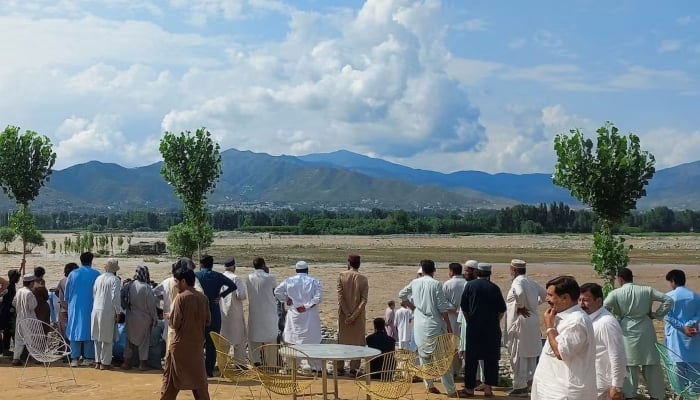River of no return
Hundreds of people helplessly watching entire episode, making videos from riverbank for around two hours is unbearable
July 06, 2025

Occasionally, there is an image or a thought that haunts you for days and disturbs your sleep. You are emotionally wounded. And I have lived through this experience this week because I just cannot erase from my mind the moving images of a family being swept away by the raging waters of the Swat River.
It would not have been the same if I had just read the story. Fatalities are regularly reported in disasters that take place in near or distant places. Photographs of, say, a burnt vehicle or a row of coffins would certainly attest to a tragedy. But the impact of a visual account of the death of so many people is very different.
Besides, I have watched it so many times on our news channels. Perhaps, social media has played up the tragedy with more graphic visuals. The very thought that hundreds of people were helplessly watching the entire episode and making videos from the riverbank for around two hours is unbearable.
There is, of course, the story of what happened. A group of tourists, apparently the guests of one of the hotels that line the bank of the river, walked over to a mound in the riverbed for a picnic breakfast on that sunny morning of Friday last week, June 27. It must have been a fun time, and the tourists did not notice that the river was coming alive, beginning to breathe.
Suddenly, then, the river swelled and the boulder on which a family of 13 was perched was surrounded by rushing currents. We are told that it was a flood, causing a surge in the river. This was clearly a grave emergency and called for an immediate response to rescue the tourists.
We have seen how the mound gradually submerged in the rising currents and the members of the family began to be swept away. It is this scene that has stuck in my mind. Apparently, it took two hours after the first alarm was raised. Two hours in a situation like this is a long time. In a life-threatening emergency, every second counts, and there have been examples of how quick responses and daring, innovative actions can save lives.
There, of course, were explanations by the officials and shifting of blame. Nationally, there was an outcry and expressions of grief, as well as political point-scoring. Officials claimed that lives were saved in other similar situations.
Obviously, local officials of the National Disaster Management Agency (NDMA) and hoteliers and guides would be well aware of the behaviour of the Swat River and of mountain streams. But what safety measures are in place, and how are tourists advised about the precautions they should take?
We continually strive to attract foreign tourists and capitalise on the great potential that Pakistan offers as a destination. There are reasons why tourism has not made us a rich country. We do need the necessary infrastructure. But we also need a society that is at peace with itself and is open socially.
Coincidentally, we saw an example of how a rescue operation is conducted just two days after the Swat tragedy. On Sunday, a little girl and her father fell into the ocean from a cruise ship when it had just left the Bahamas. There are videos of what happened next, made by several passengers.
There are separate accounts of how the five-year-old girl fell. Her father jumped after her to save her. Luckily, he found his daughter and was able to hold on until they were rescued by a ‘tender’ — a bright yellow boat — launched from the ship. Before that, the crew were tossing orange rings into the water. Roughly, 20 minutes passed between the child’s fall and the pair’s rescue.
Yes, they have so many more resources, better skills and equipment for a rescue operation. But we have to have our own devices to save lives. One thought: couldn’t a helicopter drop life jackets for the marooned tourists?
Finally, my emotional involvement with the Swat tragedy was, I think, deepened because of my childhood fascination with mountainous rivers. In fact, rivers in general. In my travel pieces that I wrote in Urdu, there is one on how, metaphorically, I have 'collected' rivers. I have been fortunate to be able to see many of the great rivers of the world.
In a similar vein, the Swat tragedy awakened in my mind the forgotten memories of watching the film 'River of No Return' when I was in my early teens. Marilyn Monroe was the female lead, but the central character was a ferocious river in a hilly terrain on which two people lose control of their craft.
There is actually a river in the US state of Idaho known as the River of No Return. The Sakmon River, with its swift currents and large rapids, presents the challenge of ‘white water’ rafting. However, one can be sure that all necessary safety measures are professionally ensured during such death-defying adventures.
In one of his poems, T S Eliot has portrayed the river as a “strong brown god" – a powerful and somewhat untamed force. We may look at the Swat River as a manifestation of this imaginative description. But my most recent encounter with a river and with mountain streams was exceptionally intimidating.
In June 2022, I had the opportunity to visit Gilgit-Baltistan as a member of the Human Rights Commission of Pakistan’s fact-finding mission, with Salima Hashmi and some members of HRCP staff. Our focus was on concerns about the region's constitutional status, human rights and governance.
How did the Gilgit River figure in our deliberations? There were reports of an increasing number of suicides by young women, by jumping into the ferocious and thunderous rapids. But our inquiries suggested that some of those ‘suicides’ could be ‘honour’ killings.
I recall looking down at the river from various vantage points and thinking of the young women who were lost in its deadly currents. For me, this too was the river of no return.
Disclaimer: The viewpoints expressed in this piece are the writer's own and don't necessarily reflect Geo.tv's editorial policy.
The writer is a senior journalist. He can be reached at: ghazi_salahuddin @hotmail.com
Originally published in The News









